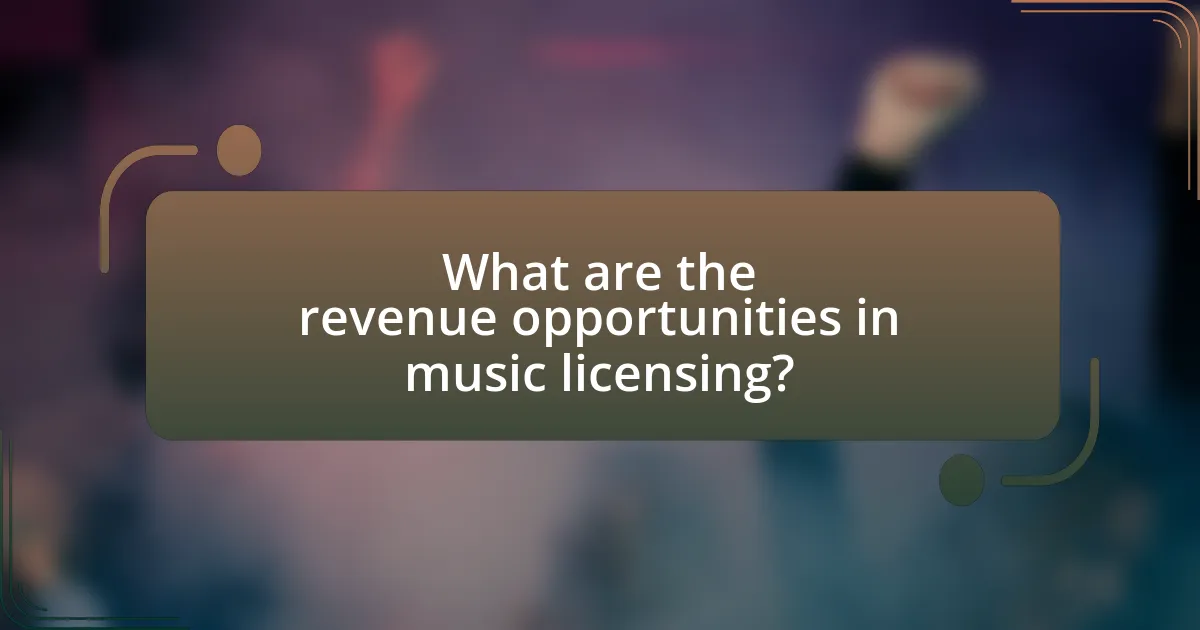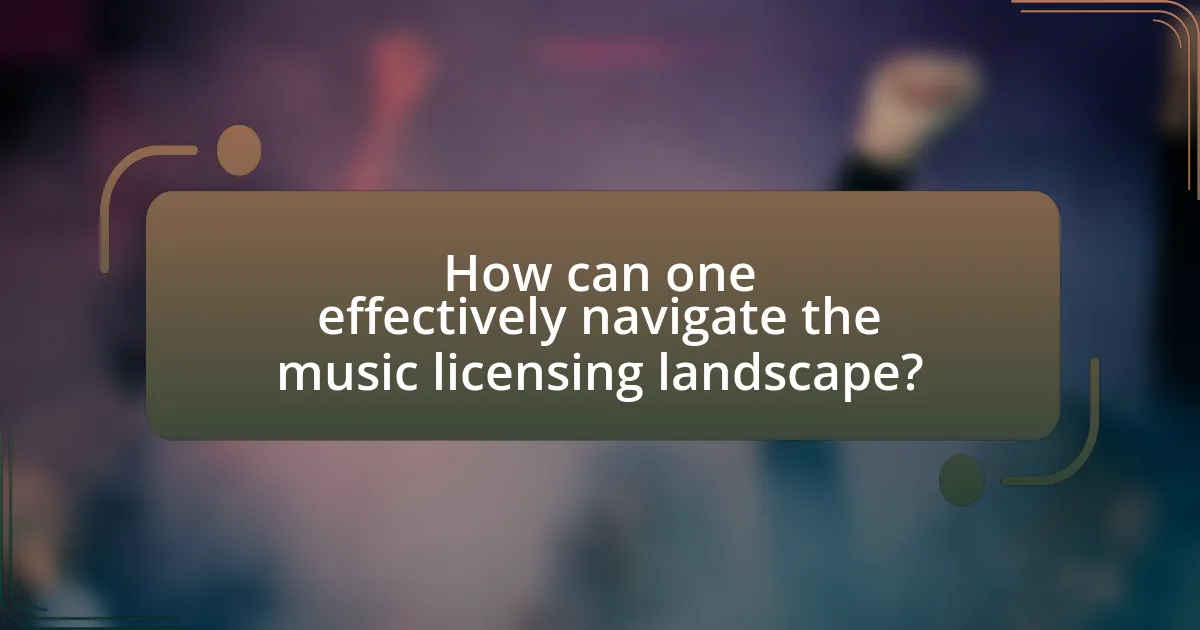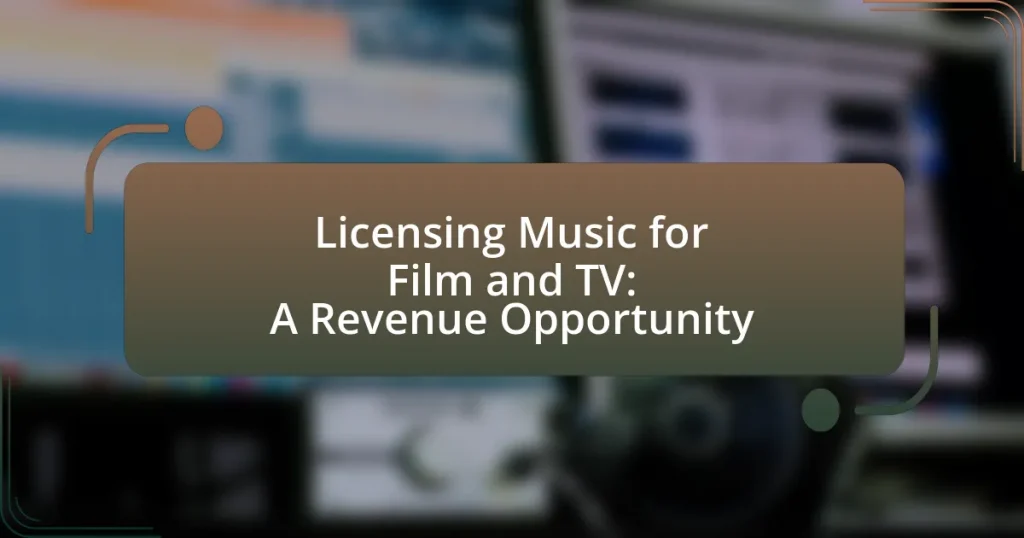Licensing music for film and TV involves obtaining legal permission to use music in audiovisual productions, ensuring compliance with copyright laws and compensating original artists. The process includes identifying rights holders, negotiating terms, and finalizing agreements, with various stakeholders such as music creators, publishers, and production companies playing crucial roles. The article explores the importance of music licensing for filmmakers and producers, the potential legal implications of using unlicensed music, and the revenue opportunities available through synchronization fees and royalties. Additionally, it addresses best practices for navigating the licensing landscape, maximizing revenue, and enhancing audience engagement through strategic music choices.

What is Licensing Music for Film and TV?
Licensing music for film and TV is the process of obtaining legal permission to use a piece of music in audiovisual productions. This involves negotiating rights with the copyright holder, which can include songwriters, publishers, or record labels, to ensure that the music can be legally incorporated into films, television shows, commercials, or other media. The licensing process is essential for creators to avoid copyright infringement and to compensate the original artists, as it often involves payment of a fee or royalties based on the usage of the music.
How does the licensing process work in the film and TV industry?
The licensing process in the film and TV industry involves obtaining permission to use copyrighted music in visual media. This process typically begins with identifying the rights holders of the music, which can include songwriters, publishers, and record labels. Once the rights holders are identified, filmmakers or producers negotiate terms, including fees and usage rights, often through a synchronization license for the composition and a master use license for the recording.
The negotiation process can vary in complexity based on the popularity of the music and the intended use in the film or TV show. For example, using a well-known song in a major production may involve higher fees and more stringent terms compared to lesser-known tracks. Additionally, the licensing agreements must comply with copyright laws, which protect the intellectual property of the music creators.
In 2020, the global music licensing market was valued at approximately $5.6 billion, highlighting the financial significance of this process in the industry. This demonstrates that effective licensing not only secures legal use of music but also represents a substantial revenue opportunity for both rights holders and producers.
What are the key steps involved in licensing music?
The key steps involved in licensing music include identifying the type of license needed, negotiating terms, obtaining permission from rights holders, and finalizing the agreement. First, the type of license required—such as synchronization or mechanical—must be determined based on the intended use of the music. Next, terms such as duration, territory, and fees are negotiated with the rights holders, which may include songwriters, publishers, and record labels. After reaching an agreement, permission must be formally obtained, ensuring all parties consent to the use of the music. Finally, the licensing agreement is documented and signed, solidifying the legal use of the music in the specified context. These steps are essential to ensure compliance with copyright laws and to protect the interests of all parties involved.
Who are the main stakeholders in the licensing process?
The main stakeholders in the licensing process for music in film and TV include music creators, music publishers, production companies, and licensing agencies. Music creators, such as songwriters and composers, own the rights to their works and seek to license them for use. Music publishers manage these rights and facilitate the licensing process on behalf of the creators. Production companies are responsible for the creation of the film or TV show and require music to enhance their projects, thus engaging in licensing agreements. Licensing agencies act as intermediaries, helping to negotiate and finalize licensing deals between the creators and production companies. Each stakeholder plays a crucial role in ensuring that music is legally and appropriately used in visual media, contributing to the overall revenue generated from these licensing agreements.
Why is music licensing important for filmmakers and TV producers?
Music licensing is crucial for filmmakers and TV producers because it ensures legal access to music, protecting them from copyright infringement. Without proper licensing, filmmakers and producers risk facing legal consequences, including fines and lawsuits, which can jeopardize their projects and financial stability. Additionally, licensed music can enhance the emotional impact of a film or show, contributing to its overall success and audience engagement. According to a study by the Music Industry Association, licensed music can increase viewer retention by up to 30%, demonstrating its value in creating memorable content.
What legal implications arise from using unlicensed music?
Using unlicensed music can lead to significant legal implications, including copyright infringement claims, monetary damages, and potential legal action from rights holders. Copyright law protects the rights of creators, and unauthorized use of their music can result in lawsuits, which may demand compensation for damages that can range from statutory damages to actual damages, depending on the case. Additionally, using unlicensed music can result in the loss of distribution rights for films or TV shows, as platforms often require proof of proper licensing before allowing content to be aired or distributed.
How does licensed music enhance the storytelling in film and TV?
Licensed music enhances storytelling in film and TV by creating emotional resonance and establishing context. The integration of specific songs or compositions can evoke particular feelings, helping to deepen the audience’s connection to characters and plot developments. For instance, a well-placed song during a pivotal scene can amplify tension or joy, guiding viewers’ emotional responses. Research indicates that music can influence audience perception and memory, making scenes more memorable and impactful. A study published in the Journal of Media Psychology found that music significantly affects emotional engagement, demonstrating its crucial role in narrative effectiveness.
What types of music can be licensed for film and TV?
Various types of music can be licensed for film and TV, including original compositions, pre-existing songs, and stock music. Original compositions are created specifically for a project, allowing for tailored emotional and narrative alignment. Pre-existing songs are commercially released tracks that require licensing agreements for use, often enhancing the production’s appeal through recognizable melodies. Stock music, which is royalty-free or available through licensing platforms, provides a cost-effective solution for background scores or specific scenes. The licensing of these music types is governed by copyright laws, ensuring that creators receive compensation for their work while allowing filmmakers and producers to enhance their projects with appropriate soundtracks.
What are the differences between original compositions and pre-existing tracks?
Original compositions are newly created musical works specifically tailored for a project, while pre-existing tracks are previously released songs or pieces that are licensed for use. Original compositions offer unique soundscapes and can be customized to fit the narrative and emotional tone of a film or TV show, enhancing storytelling. In contrast, pre-existing tracks may evoke established associations and emotions due to their prior exposure, but they lack the tailored fit that original compositions provide. The choice between the two often depends on budget, creative vision, and the desired impact on the audience.
How do different genres of music impact licensing decisions?
Different genres of music significantly impact licensing decisions due to their varying audience appeal, emotional resonance, and marketability. For instance, upbeat pop music is often favored for commercials and light-hearted films because it evokes positive emotions and attracts a broad demographic, while dramatic orchestral scores are preferred for intense scenes in films and documentaries, enhancing the narrative’s emotional depth. Additionally, niche genres like indie or folk may be chosen for specific projects to create a unique atmosphere or to appeal to targeted audiences, as seen in films like “Garden State,” which utilized indie music to resonate with its youthful audience. The licensing fees can also vary by genre; popular genres may command higher fees due to their widespread recognition and demand, while lesser-known genres might be more affordable, allowing filmmakers to manage budgets effectively.

What are the revenue opportunities in music licensing?
Revenue opportunities in music licensing include synchronization fees, performance royalties, and mechanical royalties. Synchronization fees are paid for the use of music in visual media such as films, TV shows, and commercials, with fees ranging from a few hundred to several thousand dollars depending on the project’s scale. Performance royalties are generated when music is played publicly, collected by performance rights organizations like ASCAP and BMI, and can accumulate significantly over time. Mechanical royalties arise from the reproduction of music on physical formats or digital downloads, providing additional income streams for songwriters and publishers. According to the Music Industry Revenue Report, the global music licensing market was valued at approximately $1.5 billion in 2020, highlighting the substantial financial potential within this sector.
How can filmmakers and TV producers monetize licensed music?
Filmmakers and TV producers can monetize licensed music by incorporating it into their projects and generating revenue through various channels such as streaming, DVD sales, and licensing fees. When licensed music is used in a film or television show, it can enhance the production’s appeal, leading to increased viewership and sales. For instance, a study by the Music Business Association indicates that music can significantly boost audience engagement, which in turn can lead to higher advertising revenue and subscription rates for streaming platforms. Additionally, producers can earn money through synchronization licensing, where they receive fees for allowing their content to be used in commercials, trailers, or other media. This multifaceted approach to monetizing licensed music creates a sustainable revenue stream for filmmakers and TV producers.
What are the various revenue models associated with music licensing?
The various revenue models associated with music licensing include synchronization licensing, mechanical licensing, performance licensing, and master use licensing. Synchronization licensing allows music to be paired with visual media, generating revenue based on the usage in films, TV shows, and commercials. Mechanical licensing pertains to the reproduction of music on physical formats or digital downloads, with royalties paid to songwriters and publishers. Performance licensing involves public performances of music, where performance rights organizations collect fees from venues and broadcasters, distributing them to rights holders. Master use licensing grants permission to use a specific recording of a song, often negotiated separately from the underlying composition. These models collectively contribute to the financial ecosystem of music licensing in film and TV, with the global music licensing market projected to reach $5.2 billion by 2025, highlighting its significance as a revenue opportunity.
How does music licensing contribute to the overall budget of a project?
Music licensing significantly impacts the overall budget of a project by allocating funds for the legal rights to use specific music tracks. This allocation can range from a few hundred to several thousand dollars, depending on the popularity of the music and the scope of its use, such as in film, television, or advertising. For instance, a study by the Music Business Association indicates that licensing fees can constitute up to 20% of a production’s total budget, particularly for high-profile projects that require well-known songs. Thus, music licensing is a crucial financial consideration that directly influences the project’s overall financial planning and resource allocation.
What are the potential challenges in music licensing?
The potential challenges in music licensing include complex legal requirements, high costs, and the difficulty of obtaining permissions from multiple rights holders. Legal requirements can vary significantly across jurisdictions, making compliance challenging for filmmakers and producers. High costs arise from licensing fees, which can be prohibitive, especially for independent projects. Additionally, obtaining permissions can be complicated due to the need to negotiate with various rights holders, including songwriters, publishers, and record labels, each of whom may have different terms and conditions. These factors can hinder the timely acquisition of music, impacting production schedules and budgets.
What common pitfalls should filmmakers avoid when licensing music?
Filmmakers should avoid the common pitfalls of not understanding licensing agreements, failing to secure proper rights, and neglecting to budget for music costs. Misunderstanding licensing agreements can lead to legal disputes, as filmmakers may not grasp the specific terms regarding usage, duration, and territory. Failing to secure proper rights can result in unauthorized use of music, which can lead to costly legal repercussions and removal of the film from distribution platforms. Additionally, neglecting to budget for music costs can hinder the production process, as quality music licensing often requires significant financial investment. These pitfalls can severely impact the film’s success and the filmmaker’s reputation in the industry.
How can disputes over music rights be resolved?
Disputes over music rights can be resolved through negotiation, mediation, or legal action. Negotiation involves direct discussions between the parties to reach a mutually acceptable agreement, often facilitated by legal representatives. Mediation introduces a neutral third party to help the disputing parties find common ground without resorting to litigation. If these methods fail, legal action may be necessary, where the parties can seek resolution through the courts, often relying on copyright law to determine ownership and usage rights. Historical cases, such as the 2015 case involving Led Zeppelin’s “Stairway to Heaven,” illustrate how courts interpret music rights disputes, emphasizing the importance of clear contracts and documentation in resolving such issues.

How can one effectively navigate the music licensing landscape?
To effectively navigate the music licensing landscape, one must understand the different types of licenses required for various uses, such as synchronization licenses for film and TV. Familiarity with the licensing process, including negotiating terms and understanding rights holders, is crucial. For instance, the U.S. music licensing market generated approximately $1.5 billion in revenue in 2020, highlighting the financial significance of proper licensing. Additionally, utilizing resources like the American Society of Composers, Authors and Publishers (ASCAP) and the Broadcast Music, Inc. (BMI) can provide guidance and support in navigating this complex environment.
What best practices should be followed when licensing music?
When licensing music, it is essential to obtain the appropriate permissions from copyright holders to avoid legal issues. This involves identifying the rights needed, such as synchronization rights for film and television, and ensuring that all agreements are documented in writing. Additionally, it is crucial to negotiate fair compensation based on industry standards, which can vary depending on the project’s budget and the music’s popularity. Research indicates that clear communication with rights holders about usage intentions and duration can prevent misunderstandings and disputes. Following these best practices not only protects against copyright infringement but also fosters positive relationships within the music industry.
How can filmmakers build relationships with music rights holders?
Filmmakers can build relationships with music rights holders by actively engaging in networking opportunities and establishing clear communication channels. Attending industry events, such as film festivals and music conferences, allows filmmakers to meet rights holders face-to-face, fostering personal connections. Additionally, filmmakers should utilize social media platforms to follow and interact with music rights holders, showcasing their projects and expressing interest in collaboration. Clear communication about project needs, timelines, and budget can further strengthen these relationships, as it demonstrates professionalism and respect for the rights holders’ work. According to a study by the Music Industry Research Association, effective networking and communication are key factors in successful collaborations within the music and film industries.
What resources are available for understanding music licensing better?
Resources available for understanding music licensing better include online courses, industry guides, and legal resources. Websites like Coursera and Udemy offer courses specifically focused on music licensing, providing structured learning from industry professionals. Additionally, the American Society of Composers, Authors, and Publishers (ASCAP) and the Broadcast Music, Inc. (BMI) provide comprehensive guides and articles that explain the intricacies of music licensing. Legal resources such as the Music Licensing Collective (MLC) also offer valuable information on copyright laws and licensing agreements, ensuring that creators understand their rights and obligations. These resources collectively enhance knowledge and facilitate better decision-making in music licensing for film and TV.
What tips can help maximize revenue from music licensing?
To maximize revenue from music licensing, artists and rights holders should focus on building a diverse catalog of high-quality music that appeals to various media formats. A diverse catalog increases the chances of placement in films, TV shows, and advertisements, which can lead to higher licensing fees. Additionally, actively networking with music supervisors and industry professionals can enhance visibility and opportunities for licensing deals. According to a report by the Music Business Association, music licensing revenue in the U.S. reached $1.5 billion in 2020, highlighting the financial potential of effective licensing strategies. Engaging in targeted marketing efforts, such as showcasing music on platforms like SyncTank or Music Vine, can further attract potential licensees and increase revenue streams.
How can strategic music choices enhance audience engagement and revenue?
Strategic music choices can significantly enhance audience engagement and revenue by creating emotional connections and reinforcing storytelling in film and TV. When music is carefully selected to match the tone and mood of a scene, it can evoke specific emotions, leading to a more immersive viewing experience. For instance, a study by the University of Southern California found that films with well-integrated soundtracks can increase audience retention by up to 30%. Additionally, popular music licensing can attract larger audiences, as recognizable tracks often draw viewers who may not otherwise engage with the content. This increased viewership can translate into higher advertising revenue and subscription rates, demonstrating the financial benefits of strategic music selection in media.
What are the benefits of working with a music supervisor?
Working with a music supervisor provides several key benefits, including expertise in music licensing, access to a vast network of artists and composers, and the ability to enhance the emotional impact of visual media. Music supervisors possess specialized knowledge of copyright laws and licensing processes, ensuring that all music used is legally cleared, which mitigates the risk of costly legal issues. Their extensive connections within the music industry allow for the selection of the most suitable tracks that align with the project’s vision, ultimately enhancing the storytelling experience. Additionally, studies show that well-chosen music can significantly increase audience engagement and retention, making the collaboration with a music supervisor a strategic advantage in film and TV production.
